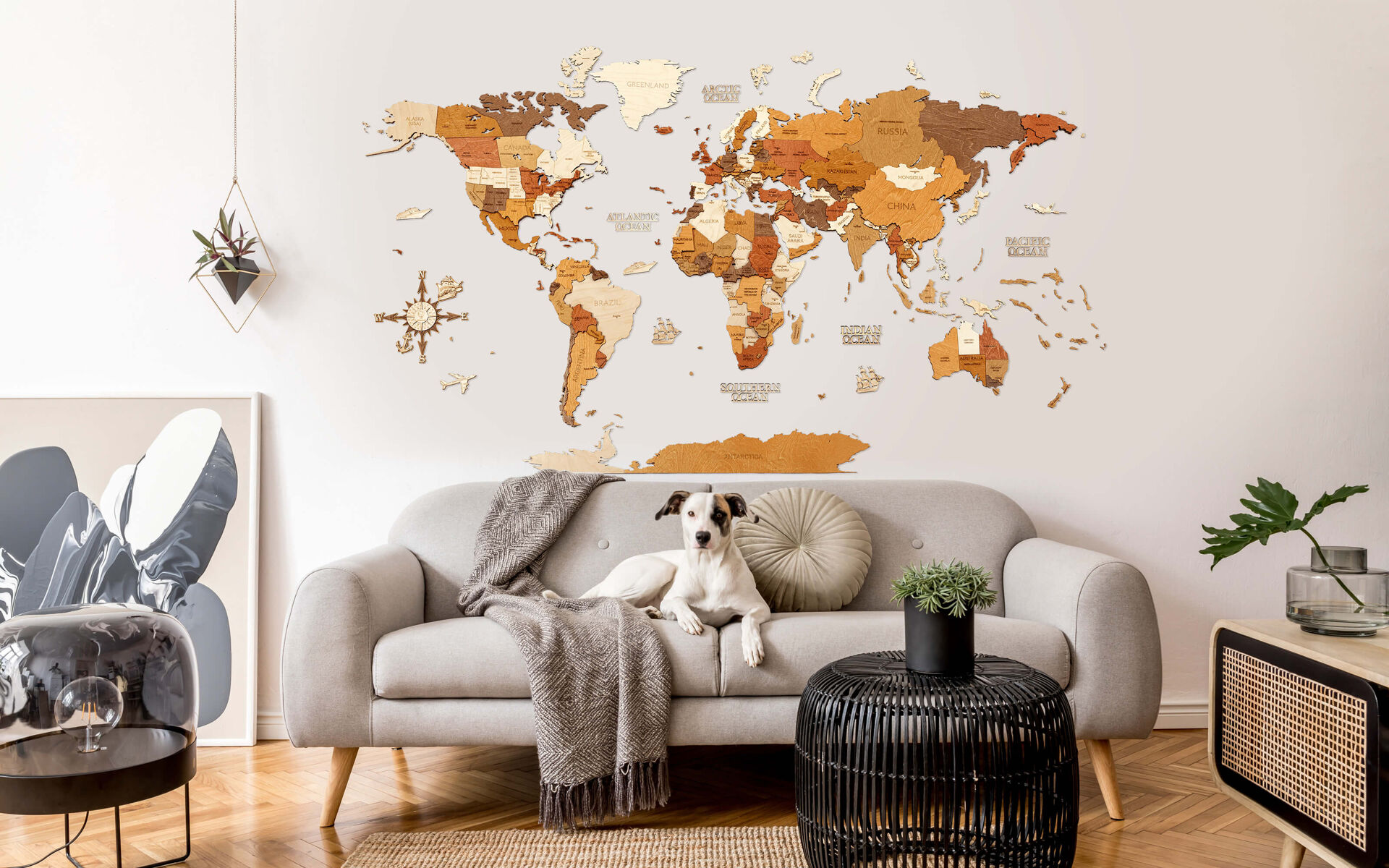Promoting Local Tourism with Handmade Wooden Maps

A Wooden Map is more than just a decorative item; it’s a powerful tool that can inspire exploration, foster local pride, and elevate tourism initiatives. This article explores how handmade wooden maps, particularly those beautifully crafted, can be leveraged to promote local tourism, engage communities, and support small businesses. By combining artistic craftsmanship, innovative marketing, and community engagement, regions can create memorable experiences that encourage residents and travelers to explore more deeply.
The Power of Visual Storytelling in Tourism

In an era dominated by instant information and social media sharing, visual storytelling remains one of the most effective ways to connect audiences with a destination. Handmade wooden maps contribute to this narrative by providing a tactile, aesthetically pleasing representation of a region. They serve as conversation starters, educational tools, and local pride symbols, making them ideal for tourism promotion.
A well-crafted wooden map combines artistry with geographic identity, turning a typical map into a piece of art that embodies the essence of a location. Its three-dimensional design adds depth and texture, making it more engaging than flat, printed maps. These maps can be customized to highlight key attractions, cultural sites, and natural wonders, thus guiding visitors on their journeys and inspiring spontaneous exploration.
Beyond visual appeal, wooden maps offer an interactive experience. They can include push pins, small souvenirs, or QR codes, transforming passive viewing into active participation. Tourists can mark places they have visited or plan future trips, creating personal connections that foster loyalty.
The Role of Handmade Wooden Maps in Cultural Identity

Handmade, especially artisanal, wooden maps act as a tangible symbol of local culture and craftsmanship. They often incorporate traditional woodworking techniques, regional materials, or iconography representative of the area. This authenticity resonates with tourists seeking genuine local experiences.
Communities that promote their cultural identity through these maps foster a sense of belonging among residents and pride among visitors. For example, a wooden map adorned with local symbols or motifs not only beautifies a space but also tells a story that aligns with regional history and values.
The bespoke nature of handmade wooden maps makes each piece unique, emphasizing the area’s individuality. By supporting local artisans, communities can strengthen the local economy while producing a meaningful travel souvenir. These maps often become statement pieces, sparking conversations and encouraging visitors to learn more about the region’s heritage.
How Handmade Wooden Maps Can Boost Local Tourism

Implementing handmade wooden maps as part of a regional tourism strategy offers multiple benefits. These include increased visitor engagement, enhanced local branding, and incentivizing longer stays or repeat visits.
Creating Memorable Attractions

Interactive and visually striking, wooden maps can serve as focal points in visitor centers, town squares, or museums. When designed with educational elements—like highlighting historic districts or natural parks—they become immersive tools for exploration.
Additionally, hosting events around the maps, such as map unveiling ceremonies or artisanal workshops, can draw media attention and attract more visitors. Such initiatives make visits more memorable, encouraging word-of-mouth promotion.
Promoting Off-the-Beaten-Path Destinations

Many regions have hidden gems that are overlooked by mainstream tourism. Custom wooden maps can spotlight these lesser-known attractions, encouraging visitors to venture beyond typical hotspots. For example, integrating a map into a local festival or outdoor adventure park guides tourists to explore new areas, which helps distribute tourism pressure more evenly.
Supporting Local Artisans and Small Businesses

The craftsmanship behind handmade wooden maps encourages partnerships with local artisans. When regions promote these products, they create a ripple effect benefiting woodworking studios, gift shops, and hospitality venues. These collaborations not only enhance the local experience but also foster economic sustainability.
Using Wooden Maps in Digital and Physical Promotions
Combining traditional handmade maps with digital platforms amplifies their impact. QR codes embedded in the maps can lead visitors to interactive guides, audio tours, or social media content. This fusion of analog and digital enhances engagement and enriches the overall visitor experience.
Such strategic use of wooden maps can be integrated into broader promotional campaigns, including social media contests, photo-sharing initiatives, or influencer collaborations, further expanding their reach.
Designing Custom Wooden Maps for Tourism Campaigns

Creating an effective handmade wooden map tailored to a destination’s unique qualities requires thoughtful planning and artistic vision. It involves selecting the right design elements, materials, and features that resonate with both locals and tourists.
Selecting the Right Material and Craftsmanship
High-quality wood varieties such as oak, walnut, or pine provide durability and aesthetic appeal. The natural grains and colors contribute to a map’s visual charm, making each piece unique.
Artisans use precise carving, inlay, and finishing techniques to ensure the map is both durable and attractive. When properly crafted, wooden maps become heirloom pieces that travelers cherish and revisit.
Incorporating Key Destinations and Hidden Gems
A comprehensive wooden map highlights major attractions but also emphasizes lesser-known sites, fostering natural curiosity. Customization allows incorporating local landmarks, historical sites, natural reserves, and cultural districts.
Markers such as engraved symbols or embedded emblematic pieces help distinguish different categories of sites. Including QR codes or small info cards encourages visitors to learn more about each location digitally.
Interactive Features and Personalization
Adding features like push pins, removable souvenirs, or writable surfaces transforms maps into interactive tools. For example, visitors can mark their visited sites or future itinerary plans. Personalization options, such as engraving names or dates, make these maps special souvenirs.
Collaborating with local artisans for bespoke designs enhances authenticity and encourages a sense of community involvement.
Strategies for Promoting Handmade Wooden Maps to Tourists

Once a beautiful wooden map is designed, the next step involves effective promotion. Strategies include integrating the maps into tourism infrastructure, digital marketing, and educational outreach.
Placement in High-Traffic Areas
Placing wooden maps in prominent locations such as airports, train stations, hotel lobbies, or visitor centers maximizes visibility. These are the first touchpoints for many tourists and offer prime opportunities to inspire exploration.
Creating Engaging Experiences and Events
Organizing map-themed events like guided tours, photo contests, or “map unveiling” ceremonies can draw attention. These activities encourage visitors to engage with the product and share their experiences on social media, thus amplifying reach.
Leveraging Digital Campaigns and Social Media
Sharing high-quality images of the wooden maps and stories behind their design can attract online audiences. Collaborations with influencers, or encouraging visitors to post their personalized maps, builds a community around the identity and beauty of the region.
Educational and Cultural Programs
Educational initiatives that integrate wooden maps into school programs, workshops, or local history exhibits foster a deeper connection with the region’s story. These programs target younger audiences and families, cultivating future advocates of local tourism.
Measuring the Impact of Wooden Maps on Local Tourism

To evaluate how well handmade wooden maps promote local tourism, formal assessments should be part of a strategic plan. Data collection and analysis help refine approaches for maximum impact.
| Metric | Description | How it Helps |
|---|---|---|
| Visitor Engagement | Number of interactions at maps (e.g., pins placed, photos shared) | Indicates visitor interest and participation |
| Social Media Mentions | Frequency and reach of map-related posts | Measures online visibility and word-of-mouth promotion |
| Tourism Statistics | Changes in visitor numbers before and after implementation | Demonstrates quantitative impact |
| Local Business Growth | Increase in sales or foot traffic in partner businesses | Shows economic benefits |
Quantitative data combined with qualitative insights provide a comprehensive view of how handmade wooden maps influence tourist behavior and regional growth.
Conclusion

In a competitive tourism landscape, creative and authentic promotional tools play a vital role. Handmade wooden maps, with their aesthetic appeal and interactive capabilities, offer an exceptional means to promote local tourism. They facilitate storytelling, highlight hidden gems, and support local artisans, all while creating memorable visitor experiences.
As regions increasingly recognize the value of tangible, community-focused souvenirs, the Wooden Map stands out as a symbol of local pride and exploration. When strategically integrated into tourism initiatives, these maps can transform how visitors perceive and experience a destination—making every trip not just a visit but an immersive journey of discovery and connection.
By embracing craftsmanship and storytelling, communities can turn their landscapes into living works of art, inspiring both locals and visitors to explore, appreciate, and promote their unique corners of the world.
Remember: For a charming and elegant addition to your community project, consider the 3D wooden world map. It’s an excellent example of how thoughtfully crafted maps can serve as both aesthetic and functional elements in tourism promotion.
